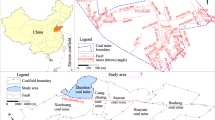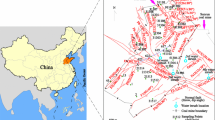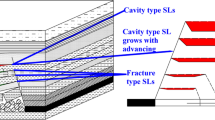Abstract
Effective risk assessment of underground water inrush is the prerequisite and basis for mine water hazard control and safe mining. An inrush risk assessment system was set up, based on a comprehensive analysis of the factors of mine water inrush risk and improved analytic hierarchy process (AHP). A new judgment matrix was constructed based on a scale of 1–9. The Dempster-Shafer (D–S) synthetic rule was improved on the basis of improved AHP; the frame of discernment proposed includes water-inrush, critical condition, and no water-inrush. A water-inrush integration decision-making model was thus established. Finally, using a typical underground mine in China, the new model was verified using this method. The probability of water inrush was 0.822, which is broadly in line with the actual situation, indicating that the model is feasible and applicable.
Zusammenfassung
Eine effective Risikoeinschätzung für untertägige Wassereinbrüche ist die Voraussetzung und Basis der Kontrolle von Bergwassergefahren und für sicheren Bergbau. Ein System der Einbruchsrisikoeinschätzung wurde erstellt, basierend auf einer umfassenden Analyse der Faktoren von Wassereinbruchsrisiken und einem verbesserten analytischen Hierarchieprozess (AHP). Eine neue Beurteilungsmatrix mit einem Maßstab von 1-9 wurde konstruiert. Basierend auf dem verbesserten AHP, wurde die synthetische Dempster-Shafer (D-S) Regel verbessert. Der vorgeschlagene Urteilsrahmen umfaßt Wassereinbruch, kritische Bedingungen, und kein Wassereinbruch. Damit waren Entscheidungen möglich. Unter Nutzung einer typischen Untertagemine in China wurde schließlich das Modell verifiziert. Die Wahrscheinlichkeit eines Wassereinbruchs war 0.822, mit der tatsächlichen Situation etwa übereinstimmend. Somit war das Modell als machbar und anwendbar bezeugt.
Resumen
La evaluación efectiva del riesgo de la irrupción de agua subterránea es el requisito previo y la base para el control de los riesgos del agua de la mina y de la seguridad de la minería. Se estableció un sistema de evaluación de riesgo de irrupción, basado en un análisis exhaustivo de los factores del riesgo de entrada de agua de la mina y el proceso mejorado de jerarquía analítica (AHP). Se construyó una nueva matriz de juicio basada en una escala de 1-9. La regla sintética de Dempster-Shafer (D-S) se mejoró sobre la base de la mejora de AHP; el marco de discernimiento propuesto incluye irrupción de agua, condición crítica y no irrupción de agua. De este modo se estableció un modelo de toma de decisiones de integración de la irrupción de agua. Finalmente, utilizando una mina subterránea típica en China, el nuevo modelo se verificó utilizando este método. La probabilidad de entrada de agua fue de 0,822, lo que está en línea con la situación actual indicando que el modelo es factible y aplicable.
抽象
有效的矿井突水危险性评价是矿井水害防治和安全开采的前提与基础。基于矿井突水危险因素综合分析和改进的层次分析法(AHP),建立了矿井突水危险性评价系统。用1-9 标度法构造了一个新的判断矩阵。在改进的AHP 基础上,进一步改进Dempster-Shafer (D-S)合成规则,建立由突水、临界和不突水组成的识别框架,构建了突水综合决策模型。以中国一个典型的地下煤矿为例,验证了该模型;突水概率为0.822,与实际情况吻合,证明了该模型的可行性和适用性。


Similar content being viewed by others
References
Chai TK, Yao LZ (2014) Coal mining water inrush factors analysis and classification floor water-resisting layer. Shandong Coal Sci Tech (1):115–117 (in Chinese)
Chen YH, Zhao JB (2004) Research on compatibility of fuzzy judgment matrices. Oper Res Manag Sci 13(1):45
Chen H, Qi H, Long RY, Zhang ML (2012) Research on 10-year tendency of China coal mine accidents and the characteristics of human factors. Safety Sci 50(4):745–750
Dempster A (1967) Upper and lower probabilities induced by a multivalued mapping. Ann Math Stat 38(2):325–339
Haenni R (2002) Are alternatives to Dempster’s rule of combination real alternatives?: comments on “About the belief function combination and the conflict management problem”. Inform Fusion 3(4):237–239
Jin DW, Wang YF (1988) Information analysis on water inrush factors of coal mine in north China. Coal Geol Explor 26(s1):30–32 (in Chinese)
Li SF (2015) Prediction for damage depth of coal seam floor based on the BP neural network. Proc, ICMSA2015, Suzhou, pp 14–19
Li B, Chen Y (2016) Risk assessment of coal floor water inrush from underlying aquifers based on GRA–AHP and its application. Geotech Geol Eng 34(1):143–154
Li JQ, Zhang ZM (2004) The consistent problems in AHP. Coll Math 20(4):71–72 (in Chinese)
Li J, Zhang HY (2011) Application of BP neural network to determine of mine water inrush sources based on Matlab. Proc, 2nd AIMSEC, 179–182, https://doi.org/10.1109/AIMSEC.2011.6010199
Li LP, Zhou ZQ, Li SC, Xue YG, Xu ZH, Shi SS (2014) An attribute synthetic evaluation system for risk assessment of floor water inrush in coal mines. Mine Water Environ 34(3):288–294
Liu QS (2009) A discussion on water inrush coefficient. Coal Geol Explor 37(4):34–37 (in Chinese)
Liu WT, Liu SL, Sun YS (2015) Risk evaluation of water inrush from coal floor based on BP neural network. Appl Mech Materials 744–746:1728–1732
Ma J, Zhang YM (2012) A new dynamic assessment for multi-parameters information of water inrush in coal mine. Energ Procedia 16:1586–1592
Min D (2014) Mine water inrush factors analysis and water disasters prevention and control measures of Shanxi Shuozhou Beiling coal mine. Value Eng 7:311–312 (in Chinese)
Murphy C (2000) Combining belief functions when evidence conflicts. Decis Support Syst 29(1):1–9
Qiu M, Shi L, Teng C, Zhou Y (2017) Assessment of water inrush risk using the Fuzzy Delphi Analytic Hierarchy Process and Grey Relational Analysis in the Liangzhuang coal mine, China. Mine Water Environ 36:39–50
Saaty T (1980) The analytic hierarchy process: planning, priority setting, resource allocation. McGraw-Hill International Book Co, New York
Saaty T (1990) How to make a decision: the analytic hierarchy process. Eur J Oper Res 48(1):9–26
Shafer G (1976) A Mathematical theory of evidence. Princeton University Press, Princeton
Su XY, Mahadevan S, Xu PD, Deng Y (2015) Dependence assessment in human reliability analysis using evidence theory and AHP. Risk Anal 35(7):1296–1316
Wang Y, Yang WF, Li M, Liu X (2012) Risk assessment of floor water inrush in coal mines based on secondary fuzzy comprehensive evaluation. Int J Rock Mech Min 52(6):50–55
Wu Q, Fan SK, Zhou WF, Liu SQ (2013) Application of the analytic hierarchy process to assessment of water inrush: a case study for the no. 17 coal seam in the Sanhejian coal mine, China. Mine Water Environ 32(3):229–238
Xu S (1988) The Principle of Analytic Hierarchy Process. Tianjin University Press, Tianjin (in Chinese)
Yager R (1987) On the Dempster-Shafer framework and new combination rules. Inform Sci 41(2):93–138
Yang J, Qiu WH (2010) Research on consistency test and modification approach of fuzzy judgment matrix. J Syst Manage 19(1):14–18 (in Chinese)
Yang L, Liu CC, Han J, Sheng W (2012) Prediction of water inrush from coal floor based on small sample data mining technology and realization using MATLAB. J Softw 7(10):2241–2246
Zeng YF, Wu Q, Liu SQ, Zhai YL, Lian HQ, Zhang W (2018) Evaluation of a coal seam roof water inrush: case study in the Wangjialing Coal Mine, China. Mine Water Environ 37(1):174–184
Zhang YM, Cheng ZZ (2008) The application of DS evidence theory in coal mine flood prediction. J Taiyuan U Tech 39:589–589 (in Chinese)
Acknowledgements
We thank the Wangjialing no. 2 coal mine for its support of hazard determination. This study was supported by the: National Key R&D Program of China (2017YFC0602903), National Natural Science Foundation of China (51574013, 51774039), Research Fund of State Key Laboratory of Coal Resources and Safe Mining, CUMT (SKLCRSM18KF006), and Fundamental Research Funds for the Central Universities (FRF-TP-17-024A1).
Author information
Authors and Affiliations
Corresponding authors
Rights and permissions
About this article
Cite this article
Ruan, Z., Li, C., Wu, A. et al. A New Risk Assessment Model for Underground Mine Water Inrush Based on AHP and D–S Evidence Theory. Mine Water Environ 38, 488–496 (2019). https://doi.org/10.1007/s10230-018-00575-0
Received:
Accepted:
Published:
Issue Date:
DOI: https://doi.org/10.1007/s10230-018-00575-0




